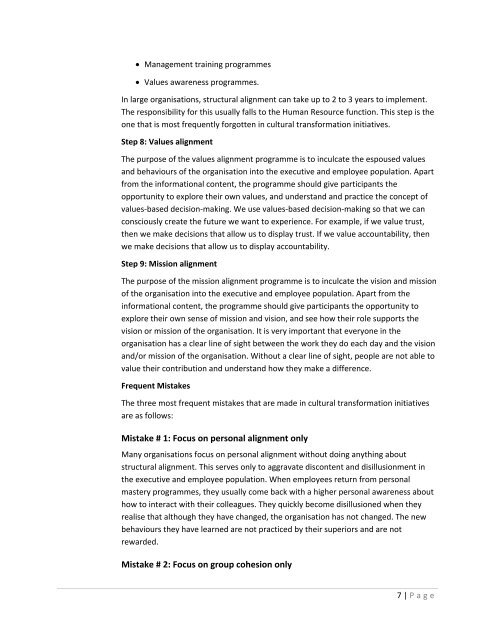Cultural Transformation
Cultural Transformation
Cultural Transformation
You also want an ePaper? Increase the reach of your titles
YUMPU automatically turns print PDFs into web optimized ePapers that Google loves.
• Management training programmes<br />
• Values awareness programmes.<br />
In large organisations, structural alignment can take up to 2 to 3 years to implement.<br />
The responsibility for this usually falls to the Human Resource function. This step is the<br />
one that is most frequently forgotten in cultural transformation initiatives.<br />
Step 8: Values alignment<br />
The purpose of the values alignment programme is to inculcate the espoused values<br />
and behaviours of the organisation into the executive and employee population. Apart<br />
from the informational content, the programme should give participants the<br />
opportunity to explore their own values, and understand and practice the concept of<br />
values‐based decision‐making. We use values‐based decision‐making so that we can<br />
consciously create the future we want to experience. For example, if we value trust,<br />
then we make decisions that allow us to display trust. If we value accountability, then<br />
we make decisions that allow us to display accountability.<br />
Step 9: Mission alignment<br />
The purpose of the mission alignment programme is to inculcate the vision and mission<br />
of the organisation into the executive and employee population. Apart from the<br />
informational content, the programme should give participants the opportunity to<br />
explore their own sense of mission and vision, and see how their role supports the<br />
vision or mission of the organisation. It is very important that everyone in the<br />
organisation has a clear line of sight between the work they do each day and the vision<br />
and/or mission of the organisation. Without a clear line of sight, people are not able to<br />
value their contribution and understand how they make a difference.<br />
Frequent Mistakes<br />
The three most frequent mistakes that are made in cultural transformation initiatives<br />
are as follows:<br />
Mistake # 1: Focus on personal alignment only<br />
Many organisations focus on personal alignment without doing anything about<br />
structural alignment. This serves only to aggravate discontent and disillusionment in<br />
the executive and employee population. When employees return from personal<br />
mastery programmes, they usually come back with a higher personal awareness about<br />
how to interact with their colleagues. They quickly become disillusioned when they<br />
realise that although they have changed, the organisation has not changed. The new<br />
behaviours they have learned are not practiced by their superiors and are not<br />
rewarded.<br />
Mistake # 2: Focus on group cohesion only<br />
7 | P age

















